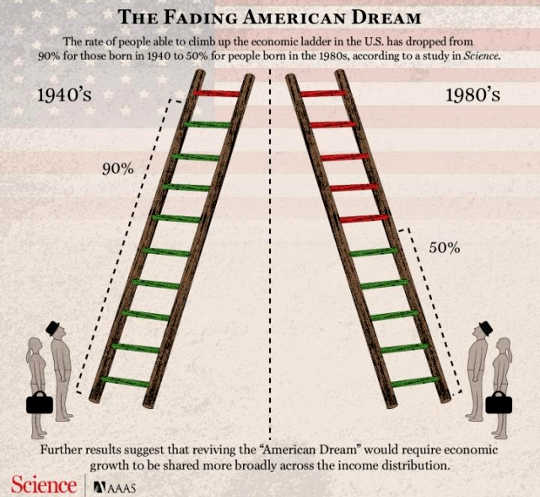
The authors of the new study found a sharp decline in absolute mobility and that reversing the trend means "more equal economic redistribution." (Photo: Jeremy Brooks/flickr/cc)
Whither the American Dream?
It may not be totally dead, but a new study suggests that it is certainly on life support.
Published in the American Association for the Advancement of Science journal Science, the team of researchers led by Raj Chetty and David Grusky of Stanford University used data from federal income tax returns and U.S. Census and Current Population Surveys to look at trends of this "absolute mobility," or earning more than one's parents.
What they found was a dramatic decline over the past several decades. While nearly all—over 90 percent—of children born in 1940 were able to earn more than their parents, that figure drops to 50 percent for children born in the 1980s.
The authors write that the decline was particularly acute "in the industrial Midwest," states like Michigan, and hit the middle class hardest, though they note "that declines in absolute mobility have been a systematic, widespread phenomenon throughout the United States since 1940."

An infographic conveying results by Chetty et al., which reveal that the probability for children to attain a higher income than their parents has dropped dramatically -- from more than 90 percent for children born in 1940 to 50 percent for children born in the 1980s. This material relates to a paper that appeared in the 28 April 2017, issue of Science, published by AAAS. The paper, by R. Chetty at Stanford University in Stanford, CA, and colleagues was titled, 'The fading American dream: Trends in absolute income mobility since 1940.' (Image and caption: AAAS/Science)Intertwined with the ability to move upward is the inequality gripping the nation. They note: "Higher GDP growth rates do not substantially increase the number of children who earn more than their parents because a large fraction of GDP goes to a small number of high income earners today." Put another way, "Absolute mobility is highest when GDP growth rates are high and growth is spread broadly across the distribution."
Thus, a big part of reversing the trend means "more equal economic redistribution," the researchers conclude.
Noting the economic benefits that have been reaped most by those at the upper echelons, noted commentator Bill Moyers wrote months ago of "an ugly truth about America: inequality matters. It slows economic growth, undermines health, erodes social cohesion and solidarity, and starves education."
It was a major theme of the presidential campaign of Sen. Bernie Sanders (I-Vt.), who continues to rail against the country's "massive income and wealth inequality," and condemned President Donald Trump's budget blueprint last month as "morally obsence" for including "unacceptably painful cuts to programs that senior citizens, children, persons with disabilities, and working people rely on to feed their families, heat their homes, put food on the table, and educate their children."
This article originally appeared on Common Dreams
About The Author
Andrea Germanos is senior editor and a staff writer at Common Dreams.
Related Books
at InnerSelf Market and Amazon

























